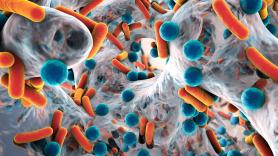2. The search for new antibiotics
“In the search for new antibiotics with new mechanisms of action, nature is still a great place to look,” noted Sara Soto, associate professor at ISGlobal Barcelona and co-leader of this B·Debate session. Specifically, “little exploration has been done in the seas and oceans, taking into account that up to 10,000 new species are discovered each year.”
Additionally, as noted Domingo Gargallo-Viola, CSO of ABAC Therapeutics, “bacteria are much more genetically diverse than mammals. If antibiotics have traditionally targeted very conservative evolutionary aspects, how can we keep finding new broad-spectrum antibiotics?” His answer is to follow a path similar to that used in precision oncology, targeting specific pathogens.
This is the path Hasan Jafri presented. The Director of Clinical Research at AstraZeneca presented a new type of monoclonal antibodies that target Pseudomonas aeruginosa, one of the pathogens that have developed critical resistance. This new approach could help minimize and/or complement the use of antibiotics and Jafri calls it a “paradigm shift”.
One of the advantages of this precision approach is that they are much more tolerant of our own bacteria, our microbiome, which suffers when we have to take broad-spectrum antibiotics and which, also subject to selective pressure, can act as a reservoir of resistances. In fact, it is directly associated with immunity, both given its function of ‘training’ the defenses and for its job as a barrier to infections. Curiously, as explained Àlex Soriano, chief of the Infectious Diseases Service at Hospital Clinic Barcelona, the feces transplants indicated to treat Clostridium difficile infections are associated with fewer recurring urinary-tract infections, possibly because the transplant decreases the amount of resistant bacteria. Likewise, the rate of blood infections is much lower than in patients treated with antibiotics.
Another novel treatment is the use of bacteriophages, viruses that naturally attack and destroy bacteria. Although they have been in use for decades, especially in former Soviet states, “we don’t have any scientific proof that they work yet,” explained Patrick Jault, who helped launch the European PHAGOBURN project in 2013. “What we have is a path towards a potential therapy,” he continues. “In general, what we are looking for is a combination, a stable cocktail of phages that can work on a broad spectrum of bacteria, but this is difficult to produce.”
As proof of concept, Jault presented the results of a study published in 2019 in which a combination of phages was used to treat Pseudomonas infections in burn patients. The cocktail was less effective than the standard treatment, but it did work, “and at a much lower dose with fewer side effects,” explained Jault.
A more novel approach involves the use of peptides that inhibit protein aggregation. “Not much is known yet, but up to 70% of newly synthesized proteins aggregate (and lose function) because they are not properly formed,” explained Els Beirnaert, CEO of Aelin Therapeutics, in Belgium. This company has developed an algorithm that identifies the regions of proteins that are most susceptible to this type of aggregation. Comparing them to the human proteome, they choose the ones that could work for at least five different bacteria without affecting our proteins. With this information, they create peptides (called Pept-ins) that selectively drive the aggregation of specific proteins, leading to ‘proteostatic collapse’. “We’re still in the early stages of research, but this concept develops a new mechanism of action for new targets and seems to generate few resistances,” explained Beirnaert.
Other advances have to do with how antibiotics get to the point of infection. One of the great promises is the use of nanoparticles, with many potential advantages, like the fact that they could maximize drug efficiency at much lower doses. However, as noted Eduard Torrents, group leader at the Institute for Bioengineering of Catalonia (IBEC), “many papers have been published about this, but it hasn’t reached clinical practice yet.”
Based in part on this technology, Joan Gavaldá and his team at the antibiotics resistance lab at the Vall d’Hebron Research Institute are developing two products to fight infection by resistant microorganisms that colonize medical materials like prosthetic joints and tracheal tubes. Jointly referred to as ThermoShot, they are silver nanoparticles that allow the union of antibiotic amikacin and are susceptible to acting due to hyperthermia (through a low-intensity electric current, for example). In the laboratory, this strategy boosts antibiotic activity up to 30-fold, even with highly resistant bacteria.



